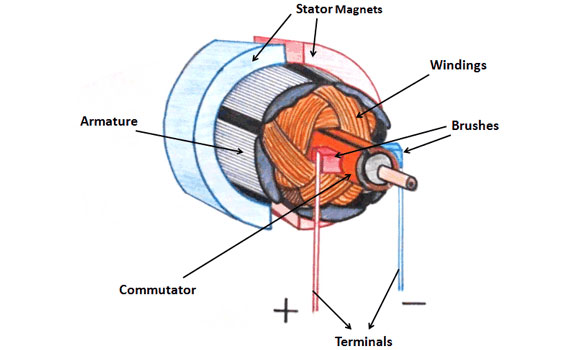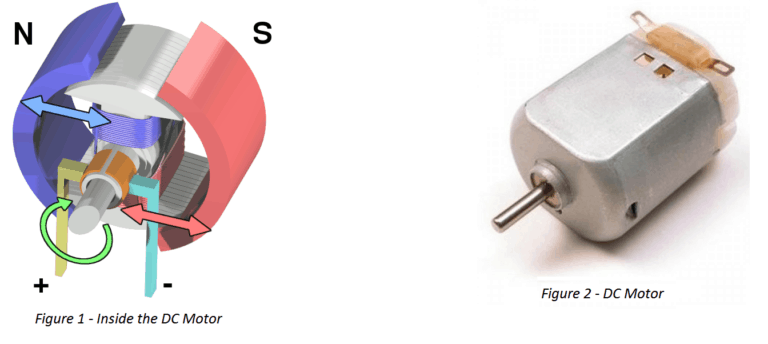DC (Direct Current) motors are devices that convert electrical energy into mechanical energy. Small DC motors, like those commonly found in toys, appliances, and small electronics, operate on the principle of electromagnetism.
Here’s a semi-technical explanation:
- Basic Components: A small DC motor typically consists of a few essential parts:
- Armature: The rotating part of the motor, usually made of a coil of wire (sometimes referred to as the rotor).
- Stator: The stationary part of the motor, which contains permanent magnets or electromagnets (sometimes referred to as the field).
- Brushes: These are conductive contacts that supply electrical current to the armature. They typically make contact with the commutator.
- Commutator: A split metal ring attached to the armature shaft, which helps to reverse the direction of current flow through the armature windings.

- Electromagnetic Principle: When electric current flows through a wire, it generates a magnetic field around the wire. In a DC motor, this principle is utilized to create a magnetic field that interacts with the permanent magnets or electromagnets in the stator.
- How It Works:
- When DC power is applied to the motor, current flows through the armature coil via the brushes and commutator.
- The current flowing through the armature coil creates a magnetic field around it, according to Ampere’s law.
- This magnetic field interacts with the magnetic field produced by the stator, causing a torque that rotates the armature.
- As the armature rotates, the commutator ensures that the direction of the current in the armature coil changes at the appropriate times, so that the magnetic forces continue to produce rotation in the same direction.
- This continuous change in the direction of current in the armature coil keeps the motor spinning.

- Controlling Speed and Direction: The speed and direction of a DC motor can be controlled by varying the voltage applied to it. Higher voltage generally results in faster rotation, while reversing the polarity of the applied voltage changes the direction of rotation.
Here’s a simpler explanation:
- Parts of the Motor: Think of the motor like a mini version of a car’s engine. It has a few main parts:
- Armature (or Rotor): This is like a tiny wheel inside the motor that spins.
- Stator: These are strong magnets that stay still and surround the spinning wheel.
- Brushes and Commutator: These are little pieces that help electricity get to the spinning wheel.
- Making It Spin:
- When you turn on the toy car, electricity flows into the motor.
- The electricity goes through the armature (the spinning wheel), creating a magnetic force.
- This magnetic force pushes against the magnets in the stator, making the wheel start to spin.

- Keeping It Spinning:
- As the armature spins, the commutator and brushes work together to switch the direction of the electricity at the right times.
- This switching keeps the magnetic forces pushing in the right way to keep the wheel spinning in a continuous circle.
- Speed and Direction:
- If you give the motor more electricity (like pushing a toy car’s accelerator), it spins faster.
- If you reverse the flow of electricity, the motor spins the other way, making the car go in reverse.
So, in simple terms, a small DC motor uses electricity to create magnetic forces that push a wheel to spin around, making things like toy cars move.






